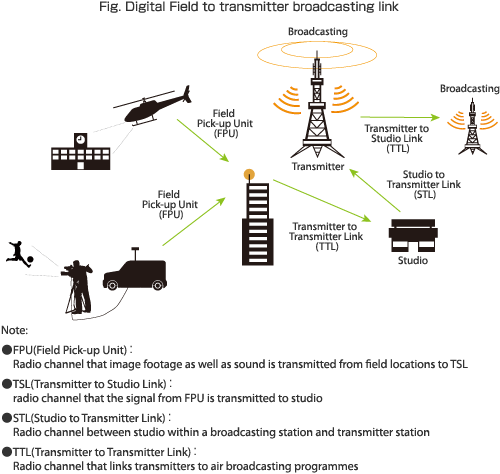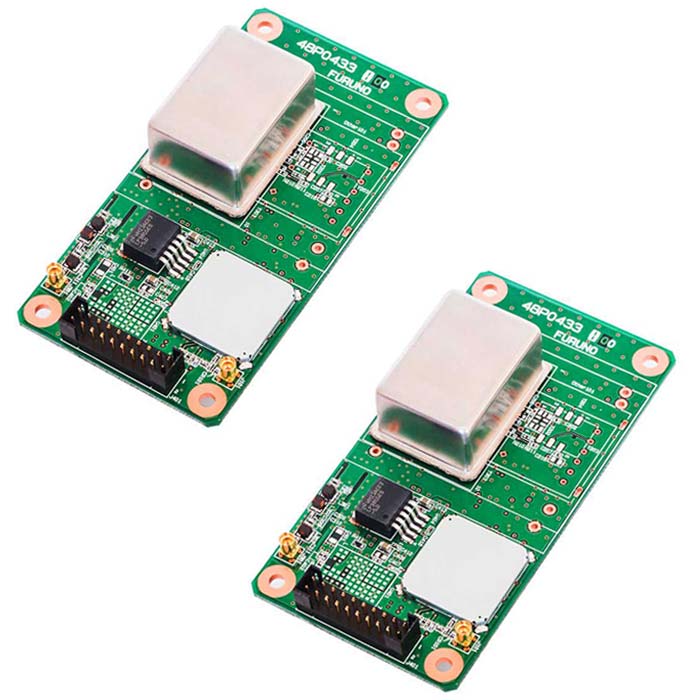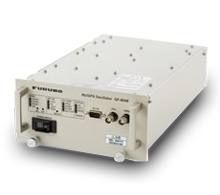Case Studies
GPS timing synchronization and terrestrial digital broadcasting
FURUNO GPS utilized for terrestrial digital broadcasting stations
In Japan, analog broadcasting is terminated in July 2011, and all the broadcasting will be shifted to digital broadcasting. In terrestrial digital broadcasting, system architecture should incorporate precise time generated from the satellite clock as well as spot-on accuracy in transmitting frequency. FURUNO GPS frequency generators are employed at various broadcasting transmitter stations, including Tokyo Tower, a famous Eiffel Tower-inspired TV tower in Tokyo. Thanks to the credibility we have earned through our experience in the field as well as outstanding stability of the equipment, our frequency generator will be employed at the new broadcasting tower, Tokyo Sky Tree, the construction of which will be completed in spring 2012. FURUNO GPS will be an integral groundwork of digital broadcasting in Japan that is spearheading the global trend of digitized broadcasting, contributing to institution of “Mobile Multi-Media Broadcasting Network”, which will commence in Japan 2012. Also, FURUNO’s GPS timing synchronization technology has increasingly employed at broadcasting infrastructure outside Japan, thanks to its technical expertise as well as stability.
When compared with analog broadcasting, strength of digital broadcasting from the viewers’ point of view lies in its high-quality image and sound production as well as its multipath-resistant stability. From the point of view of the broadcasting stations, the strength of digital broadcasting lies in the ability to hook up with a single frequency, hence contributing efficient utilization of radio waves by means of construction of Single-Frequency Network. In order to materialize Single-Frequency Networking, it is imperative to make use of a reference frequency generator of extra high degree of precision, making a GPS-controlled reference frequency generator an integral part of digital broadcasting.
Stated below is the reason for necessity of GPS for digital broadcasting:
1. Difference in required precision for transmitting frequency between analogue broadcasting and terrestrial digital broadcasting:
Conventional wisdom in broadcasting industry Japan has it that tolerable deviation in transmitting frequency for analogue broadcasting is within 120 Hz and, for terrestrial digital broadcasting, it is within 0.2 Hz. This implicates that digital broadcasting requires frequency precision of 600 times higher than it is required for analogue broadcasting. A rubidium atomic frequency generator is utilised for analogue broadcasting with its frequency stability of 5E-10/year. This would add up to the maximum frequency deviation per year of 0.385 Hz (770 MHzx5E-10). Since analogue broadcasting can tolerate the frequency deviation of up to 120 Hz, frequency correction may not be required for 311 years. However, the tolerable frequency deviation for digital broadcasting is 0.2 Hz, making it necessary to conduct frequency correction every 0.51 year (0.2 Hz/0.385 Hz) when using a rubidium atomic frequency generator. This is not feasible at all to make use of a rubidium atomic frequency generator for all the digital broadcasting stations, for frequency correction would literally be required every six months.
2. GPS -turning the impossible into the possible-
In GPS satellites, an ultra high precision clock is incorporated, the precision of which is maintained from earth stations. In order for broadcasting transmitter stations to obtain ultra precise clock time, it would suffice to receive signal from a single GPS satellite. Its accuracy over a long period of time is 1E-13, and when “1E-13/year” is computed into clock precision, deviation will only be one second in the duration of ten trillion years.
Computing hypothetically based upon 1E-13/year as the frequency stability of GPS, frequency correction may not be required for 2,597 years. This is because it would take 2,597 years to reach the tolerable frequency deviation of 0.2 Hz for digital broadcasting (0.2 Hz/(770 MHzx1E-13)). There is in fact no deviation caused at the year end. Therefore, GPS realises ultra high precision that a rubidium atomic frequency generator cannot possibly generate.

Related Products
List of Case Studies
-
Automated emergency response systems (eCall / ERA-GLONASS)

-
Smart grid and GPS/GNSS timing solutions

-
Grand Master Clock and GPS/GNSS timing solutions

-
GT in Pmod™ module (NetTimeLogic)NEW

-
Outdoor Time Synchronization: Measurement of Radio Propagation in Outdoor Mobile Communication Environment (Niigata University)

-
Time Synchronization Between Radio Telescopes: Toward Observing Radio Waves from Exoplanets (Tohoku University)NEW

-
Community broadcasting Synchronization [Multi-GNSS Disciplined Oscillator]

-
FURUNO Timing and Synchronization technology adopted base stations for Digital Terrestrial Television Broadcasting

-
FURUNO Timing and Synchronization technology adopted base station for mobile telecommunications

-
FURUNO Timing and Synchronization technology adopted for seismometer



